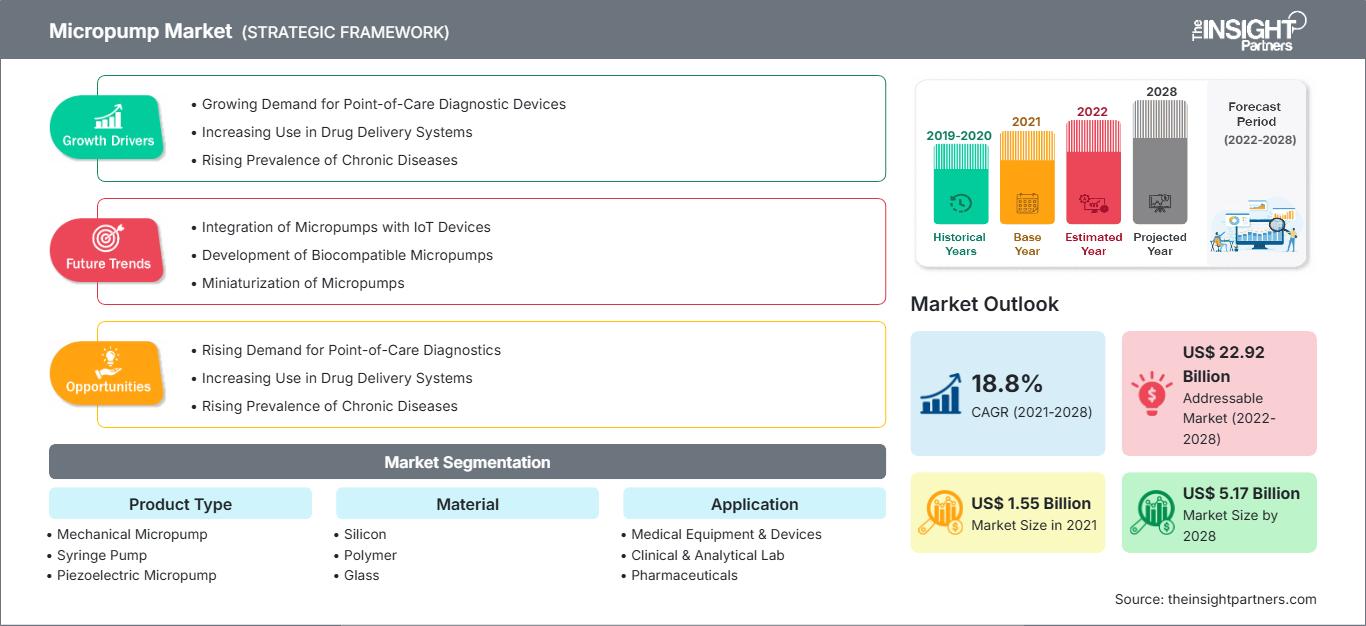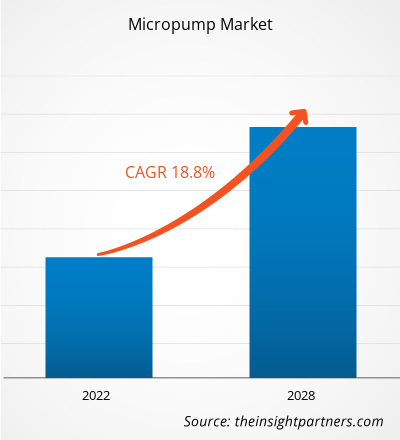Si prevede che il mercato delle micropompe raggiungerà i 5.172,86 milioni di dollari nel 2028, rispetto al valore stimato di 1.553,01 milioni di dollari nel 2021. È probabile che il mercato cresca con un CAGR del 18,8% dal 2021 al 2028.
L'ambito del mercato delle micropompe include tipologia di prodotto, materiale, applicazione, utente finale e regione. In base alla regione, il mercato delle micropompe è segmentato in Nord America, Europa, Asia-Pacifico, Medio Oriente e Africa e Sud e Centro America. Il rapporto offre approfondimenti e analisi approfondite del mercato delle micropompe, sottolineando vari parametri come tendenze di mercato, progressi tecnologici, dinamiche di mercato e analisi del panorama competitivo dei principali attori del mercato in tutto il mondo. Include anche un'analisi dell'impatto del COVID-19 nelle diverse regioni.
Personalizza questo rapporto in base alle tue esigenze
Potrai personalizzare gratuitamente qualsiasi rapporto, comprese parti di questo rapporto, o analisi a livello di paese, pacchetto dati Excel, oltre a usufruire di grandi offerte e sconti per start-up e università
Mercato delle micropompe: Approfondimenti strategici

- Ottieni le principali tendenze chiave del mercato di questo rapporto.Questo campione GRATUITO includerà l'analisi dei dati, che vanno dalle tendenze di mercato alle stime e alle previsioni.
Approfondimenti di mercato: crescente domanda di micropompe nel settore dei dispositivi mediciNegli ultimi anni, il rilascio controllato di farmaci ha posto numerose sfide, come il rilascio della quantità adeguata di farmaco al momento giusto con la minima invasività, e l'aumento della domanda di dispositivi avanzati per la somministrazione di farmaci. Alcuni dei fattori che mettono a dura prova i dispositivi convenzionali per la somministrazione di farmaci includono trattamenti a lungo termine, finestre terapeutiche ristrette, schemi di dosaggio complessi, terapie combinate e regimi di dosaggio individuali. L'emergere di sistemi microelettromeccanici (MEMS) che combinano componenti meccanici ed elettrici sta fornendo una soluzione per superare questi inconvenienti. La crescente adozione di dispositivi medici miniaturizzati ha contribuito a rimodellare il settore dei dispositivi medici. A causa dell'aumento dei costi sanitari e del passaggio all'assistenza ambulatoriale domiciliare, la domanda di prodotti più piccoli, leggeri e portatili è aumentata enormemente. La miniaturizzazione di un dispositivo medico può essere ottenuta in vari modi, uno dei più importanti è attraverso le micropompe. Le micropompe sono associate a minori costi di produzione, minori perdite, minore consumo energetico e maggiore precisione grazie al flusso controllato dei fluidi e alla somministrazione del dosaggio del farmaco nell'organismo. Possono gestire in modo efficiente volumi di liquidi estremamente ridotti. Le micropompe vengono sviluppate per una varietà di applicazioni mediche, tra cui la somministrazione transdermica di insulina, il trasporto del sangue attraverso cuori artificiali, l'iniezione di glucosio e farmaci, il trattamento ormonale e la gestione del dolore e della cura delle ferite. Inoltre, i produttori stanno lanciando un'ampia gamma di micropompe per soddisfare la crescente domanda del settore dei dispositivi medici. Ad esempio, nel novembre 2019, TTP Ventus Ltd ha lanciato una nuova serie di micropompe HP che offre portate e pressioni più elevate. Ciò ha aperto possibilità di innovazione di prodotto per applicazioni che includono la ricerca microfluidica, la diagnostica medica, i dispositivi terapeutici e i dispositivi indossabili. Inoltre, le micropompe vengono utilizzate per nuove applicazioni mediche. Ad esempio, nel settembre 2018, Sensile Medical ha ricevuto la certificazione UE per la sua micropompa indossabile progettata per il trattamento del morbo di Parkinson. Il dispositivo è facile da usare e offre funzionalità come il riempimento automatico con farmaco liquido, il display a colori, l'unità di ricarica e l'archiviazione dei dati che contribuiscono a migliorare la gestione della terapia. Approfondimenti basati sulla tipologia di prodotto
Potrai personalizzare gratuitamente qualsiasi rapporto, comprese parti di questo rapporto, o analisi a livello di paese, pacchetto dati Excel, oltre a usufruire di grandi offerte e sconti per start-up e università
Mercato delle micropompe: Approfondimenti strategici

- Ottieni le principali tendenze chiave del mercato di questo rapporto.Questo campione GRATUITO includerà l'analisi dei dati, che vanno dalle tendenze di mercato alle stime e alle previsioni.
Il mercato delle micropompe, per tipologia di prodotto, è segmentato in micropompe meccaniche, pompe a siringa, micropompe piezoelettriche, pompe peristaltiche e micropompe non meccaniche. Il segmento delle micropompe meccaniche ha detenuto la quota di mercato maggiore nel 2021, tuttavia si prevede che il segmento delle micropompe non meccaniche registrerà il CAGR più elevato del mercato, pari al 19,7%, durante il periodo di previsione.
Approfondimenti basati sui materiali
Il mercato delle micropompe, in base al materiale, è segmentato in silicio, polimero e vetro. Nel 2021, è probabile che il segmento del silicio deterrà la quota maggiore del mercato, tuttavia si prevede che il segmento dei polimeri crescerà al ritmo più rapido nei prossimi anni.
Approfondimenti basati sulle applicazioni
Il mercato delle micropompe, per applicazione, è segmentato in apparecchiature e dispositivi medici, laboratori clinici e analitici, prodotti farmaceutici, biotecnologie e altri. È probabile che il segmento delle apparecchiature e dispositivi medici deterrà la quota maggiore del mercato nel 2021 e si prevede che lo stesso segmento registrerà il CAGR più elevato, pari al 19,5% del mercato, durante il periodo di previsione.
Approfondimenti basati sull'utente finale
Il mercato delle micropompe, per utente finale, è segmentato in ospedali e centri diagnostici, aziende biotecnologiche e farmaceutiche e istituti accademici e di ricerca. Gli ospedali e È probabile che il segmento dei centri diagnostici deterrà la quota maggiore del mercato nel 2021 e si prevede che registrerà il CAGR più elevato, pari al 19,3% del mercato durante il periodo di previsione.
Strategie inorganiche come partnership, fusioni e acquisizioni sono comunemente adottate dalle aziende per soddisfare la mutevole domanda dei clienti e mantenere il proprio marchio in tutto il mondo. Gli operatori di mercato che operano nel mercato delle micropompe adottano anche strategie organiche come il lancio e l'espansione dei prodotti per ampliare la propria presenza e il proprio portafoglio prodotti a livello mondiale, nonché per soddisfare la crescente domanda.
Mercato delle micropompe
Le tendenze regionali e i fattori che influenzano il mercato delle micropompe durante il periodo di previsione sono stati ampiamente spiegati dagli analisti di The Insight Partners. Questa sezione illustra anche i segmenti e la geografia del mercato delle micropompe in Nord America, Europa, Asia-Pacifico, Medio Oriente e Africa, America Meridionale e Centrale.
Ambito del rapporto di mercato sulle micropompe
| Attributo del rapporto | Dettagli |
|---|---|
| Dimensioni del mercato in 2021 | US$ 1.55 Billion |
| Dimensioni del mercato per 2028 | US$ 5.17 Billion |
| CAGR globale (2021 - 2028) | 18.8% |
| Dati storici | 2019-2020 |
| Periodo di previsione | 2022-2028 |
| Segmenti coperti |
By Tipo di prodotto
|
| Regioni e paesi coperti | Nord America
|
| Leader di mercato e profili aziendali chiave |
|
Densità degli operatori del mercato delle micropompe: comprendere il suo impatto sulle dinamiche aziendali
Il mercato delle micropompe è in rapida crescita, trainato dalla crescente domanda degli utenti finali, dovuta a fattori quali l'evoluzione delle preferenze dei consumatori, i progressi tecnologici e una maggiore consapevolezza dei vantaggi del prodotto. Con l'aumento della domanda, le aziende stanno ampliando la propria offerta, innovando per soddisfare le esigenze dei consumatori e sfruttando le tendenze emergenti, alimentando ulteriormente la crescita del mercato.

- Ottieni il Mercato delle micropompe Panoramica dei principali attori chiave
- Micropompa meccanica
- Pompa a siringa
- Micropompa piezoelettrica
- Pompa peristaltica
- Micropompa non meccanica
Per materiale
- Silicio
- Polimero
- Vetro
Per applicazione
- Apparecchiature e dispositivi medici
- Laboratorio clinico e analitico
- Prodotti farmaceutici
- Biotecnologia
- Altro
Per utente finale
- Ospedali e centri diagnostici
- Biotecnologia e aziende farmaceutiche
- Aziende accademiche e Istituti di ricerca
Per geografia
Nord America
- Stati Uniti
- Canada
- Messico
Europa
- Francia
- Germania
- Italia
- Regno Unito
- Spagna
- Resto d'Europa
Asia Pacifico (APAC)
- Cina
- India
- Corea del Sud
- Giappone
- Australia
- Resto dell'APAC
Medio Oriente e Asia. Africa (MEA)
- Sudafrica
- Arabia Saudita
- Emirati Arabi Uniti
- Resto del MEA
America del Sud e Centro (SCAM)
- Brasile
- Argentina
- Resto del SCAM
Profili aziendali
- Advanced Microfluidics
- Microfluidica, LLC
- Alldoo Micropump Co.,Ltd
- Servoflo Corporation
- TOPS INDUSTRY AND TECHNOLOGY CO. LTD
- World Precision Instruments
- Xavitech
- Calon Cardio-Technology Ltd
- Takasago Electric, Inc.
- Medtronic
- Analisi storica (2 anni), anno base, previsione (7 anni) con CAGR
- Analisi PEST e SWOT
- Valore/volume delle dimensioni del mercato - Globale, Regionale, Nazionale
- Industria e panorama competitivo
- Set di dati Excel
Report recenti
Rapporti correlati
Testimonianze
Motivo dell'acquisto
- Processo decisionale informato
- Comprensione delle dinamiche di mercato
- Analisi competitiva
- Analisi dei clienti
- Previsioni di mercato
- Mitigazione del rischio
- Pianificazione strategica
- Giustificazione degli investimenti
- Identificazione dei mercati emergenti
- Miglioramento delle strategie di marketing
- Aumento dell'efficienza operativa
- Allineamento alle tendenze normative




















 Ottieni un campione gratuito per - Mercato delle micropompe
Ottieni un campione gratuito per - Mercato delle micropompe